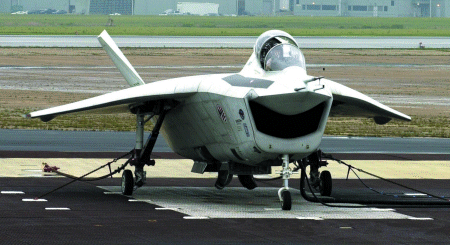PAUL LEWIS / NAS PATUXENT RIVER
Boeing and Lockheed Martin are taking different approaches to vertical landing testing
The Joint Strike Fighter (JSF) programme is entering a critical phase of flight testing with the Boeing X-32B and the Lockheed Martin X-35B short take-off vertical landing (STOVL) concept demonstrators vying to be the first to make a maiden hovering flight this week.

Boeing and Lockheed Martin have each targeted 19 June for a first hover, though this could slide by a few days for different reasons. Boeing was completing ground testing last week at NAS Patuxent River, Maryland, following the installation of a new Pratt & Whitney JSF119-614 powerplant, while the Lockheed Martin aircraft was at Palmdale awaiting flight clearance for a final software load.
The teams plan to move into the hover from different ends of the envelope. The Boeing X-32B will transition from forward to semi-jet- borne flight and, finally, to a full hover. Prior to being ferried from Edwards AFB to Patuxent River, the X-32B tested the STOVL flow switch and progressively slowed to 142kt (260km/h). "Below 100kt, we'll take smaller bites off. As we go slower we'll get lower until eventually we reach zero," says Lt Cdr Paul Stone, UK-assigned X-32 test pilot.
Lockheed Martin plans to build up to the hover from the ground, starting with sufficient power to lift the X-35B on its landing gear oleos. The aircraft will then rise approximately 5ft (1.5m) off the ground followed by a hover in ground effect between 30ft and 50ft. "In the final hover, we'll do all the air show manoeuvres, with nose nodding and left and right translation," says Scott Winship, Lockheed Martin STOVL product manager.
The X-35B will then fly to Edwards AFB to begin in-flight STOVL transitions and will conclude testing at Patuxent River. Both teams have a series of company objectives outside the mandated test programme, including transitioning from STOVL to up-and-away supersonic flight.
Source: Flight International























